3D Photonic Integration
The activities of the group aims to further develop and optimize the process technique to pattern structures by laser lithography and to produce 3D structures by 2-photon laser lithography (3D-laser writing). Although these technologies are part of our technology offer of the open access research infrastructure KNMFi we intend to continuously upgrade the technologies according to application needs and to depict the value of the technologies in various applications which are part of strategic activities of the program Science and Technology of Nanosystems.
Read more…
Our activities in laser lithography rely on the use of a Heidelberg Instruments DLW66 fs. This tool gives us the opportunity to pattern structures on wafers (up to 6 inch) with lateral dimension down to 3 µm and heights up to 300 µm depending on the used resists. This results in an aspect ratio of 5 to maximum 10. The main focus of our activities is to combine this technology with other microfabrication technologies to achieve multi scale structures with structural functionality. Further process development of thick resist layers to achieve corresponding structural heights is going on. This activity includes proper application of antireflection coatings and adhesion promotors, as well as proper resist processing.
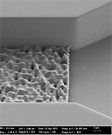 |
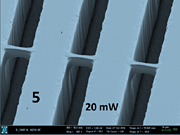 |
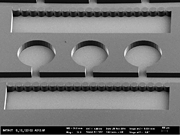 |
||
| Nanopatterned structures in a fluid channel realized by combining 2D and 3D laser writing. |
Bridge structure fabricated by 2D laser lithography with well optimized laser power to connect resist lines patterned in UV lithography. |
Polymeric microfludic chip with barrier structures (cylinders) and reservoirs made by direct laser writing. The resist thickness is 50 µm. |
3D laser writing by 2-photon lithography takes advantage of the fact that the change of resist during exposure is confined in a very small ellipsoidal volume (short 200 nm, long 600 nm). Moving this volume (voxel) allows the formation of 3D freeform structures. For running the process we are using a Photonic Professional GT from Nanoscribe. Several writing configurations with different objectives and resists can be applied as well as fast scanning in the x,y-plane by a galvoscan unit. We are looking for improving the writing procedures by development of new writing strategies especially for larger areas or volumes. Stitching volume elements and shell-writing with following flood exposure are examples. Additional new resist formulations are investigated in cooperation.
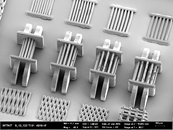 |
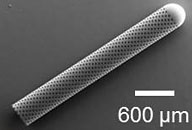 |
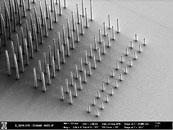 |
||
| Scaffold structures for evaluation of cell attachment and growth made by 3D direct laser writing. | Large microfluidic component. | Pillar array with increasing height and sub-µm diameter. |
Teaching, Education, Jobs
As a member of KNMFi we are offering technology specific training courses.
Klaus Bade gives lectures at the Department of Mechanical Engineering under the topic:
Fertigungsprozesse der Mikrosystemtechnik ( / )
Open Ph.D. positons will be advertised on KIT’s website for job offers.
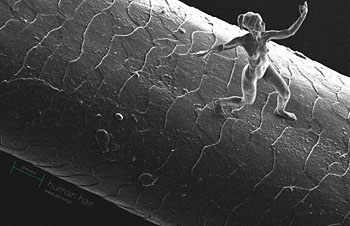
In collaboration with the British artist Jonty Hurwitz an the KNMF (KNMF) a sculpture of a woman with a height of only about 100 µm was made in IMT’ s laboratories. For pictures and a CNN video from the making of please visit: www.jontyhurwitz.com/nano/

